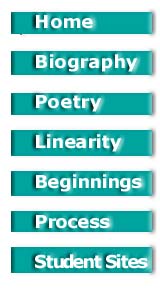My favorite web project of the year is the biography web.
By the time students begin this project, they feel comfortable
with the technology. There is less frustration, and students
are better able to problem-solve their way out of some of the
technical jams they get themselves into. Because of that, I can
spend more time talking to individual students about their writing,
and scaffold them as they make decisions about their webs. I
can also watch the processes they
use to create the webs, something I am particularly interested
in.
After students complete the poetry web
project, I ask them to reflect in their journals about the processes
they used during the poetry web process. And I ask them to discuss
what they would do differently if they had the chance. Some students
write that they would plan their webs more carefully in advance.
Others reflect that they would use more graphics or that they
would use the same background color for the whole web--issues
I discuss with them during the poetry project.
Most students sense that they would approach a new project
differently, but they are not necessarily able to articulate
how they would do that.
Though they may not be able to articulate how they would approach
a web project differently, most students admit after they begin
the biography web that there is a difference. Much of that difference
stems from the fact that the technology begins to become transparent
when students take on the biography web project. They no longer
have to think about how to save, or how to find their files.
They no longer have to be reminded how to make a link or save
an image. More students use tables when they design their lexias,
and fewer students trap their readers in an endless loop. Students
also generally provide more information in their biography webs
than they do in their poetry webs.
Their lexias are longer. They also tend to use a single background
color or wallpaper in their biography webs, even though this
is a design element I talk about during the poetry web project.
Perhaps because students are dealing with so many new textual
issues in the poetry web, many students have to tune out some
of my lessons in order to deal with the current task. But because
of that experience, they are able to use more of my advice during
the second project.
The biography project is simple enough, actually. Students
select a biography about an American who was famous between the
Spanish Conquest and 1899. This is a "departmental"
project meaning that all eighth grade teachers in the building
integrate this project into their curricula. We comb other libraries
in the area for biographies and establish a special area in the
middle school library for the books. Students browse the collection
and select a book they think will interest them. Students generally
have the option of switching one book for another if an initial
choice doesn't work out.
Other teachers in my department ask students to create a poster
on the person they read a biography about. Rather than do that,
I ask my students to create a website about the person they chose
to read about. History teachers supply students with a packet
of materials designed to help them take notes as they read. These
include a page for taking notes on a person's childhood, family,
hardships, etc. Middle school students still need guidance in
focusing their reading and the note packets help them do this.
History teachers also give students in-class reading time, a
crucial element for many students. Students are also given reading
and note-taking time in their language arts classes.
As soon as my students are ready, we return to the computer
lab and they begin working on their biography webs. This is when
I see that magic has happened.
Students maintain an enthusiasm for this project from beginning
to end. I attribute this to a new confidence in their abilities
to use the technology and their experience with hypertext in
general. I also attribute it to a sense of playfulness
that usually begins during the poetry web project, but becomes
more evident during the biography project.
Some students organize their biography webs along the same
categories as the note-taking packet that was provided by their
history teacher. So, many webs contain lexias entitled "childhood"
or "hardships," categories identified by their history
teachers. But some students feel confident enough to break away
from this and allow the subject matter to guide them in the choices
they make about what should be included in their webs. I encourage
students to do this, but I do not require it. Some students need
the support that the guided note-taking provides when they plan
their webs. Others are more comfortable or more confident in
their literacy skills to risk going outside the framework established
by their history teacher.
Our classes at Portland Middle School are heterogenously grouped.
We have all ability levels mixed in--from special education students
to those who would be classified as gifted. The beauty of heterogeneous
grouping and such open-ended tasks as the biography and poetry
webs is that individual students can wrestle with text at their
levels of ability. All students are free to take risks as they
see fit. While simply writing linked text is a risk for some
students, breaking out of the guided notes organization and playing
with textual features such as tables represent risk-taking
for other students. And often when one students sees the results
of another student's risk-taking, that student wants to attempt
something new. This brings about a marvelous sense of cooperation
and play among students, and it helps
push all students' literacy levels.
And, students who were concerned about getting the text written
focus on that part of the process first, and sometimes only insert
images at the very end of the process when time is running out.

